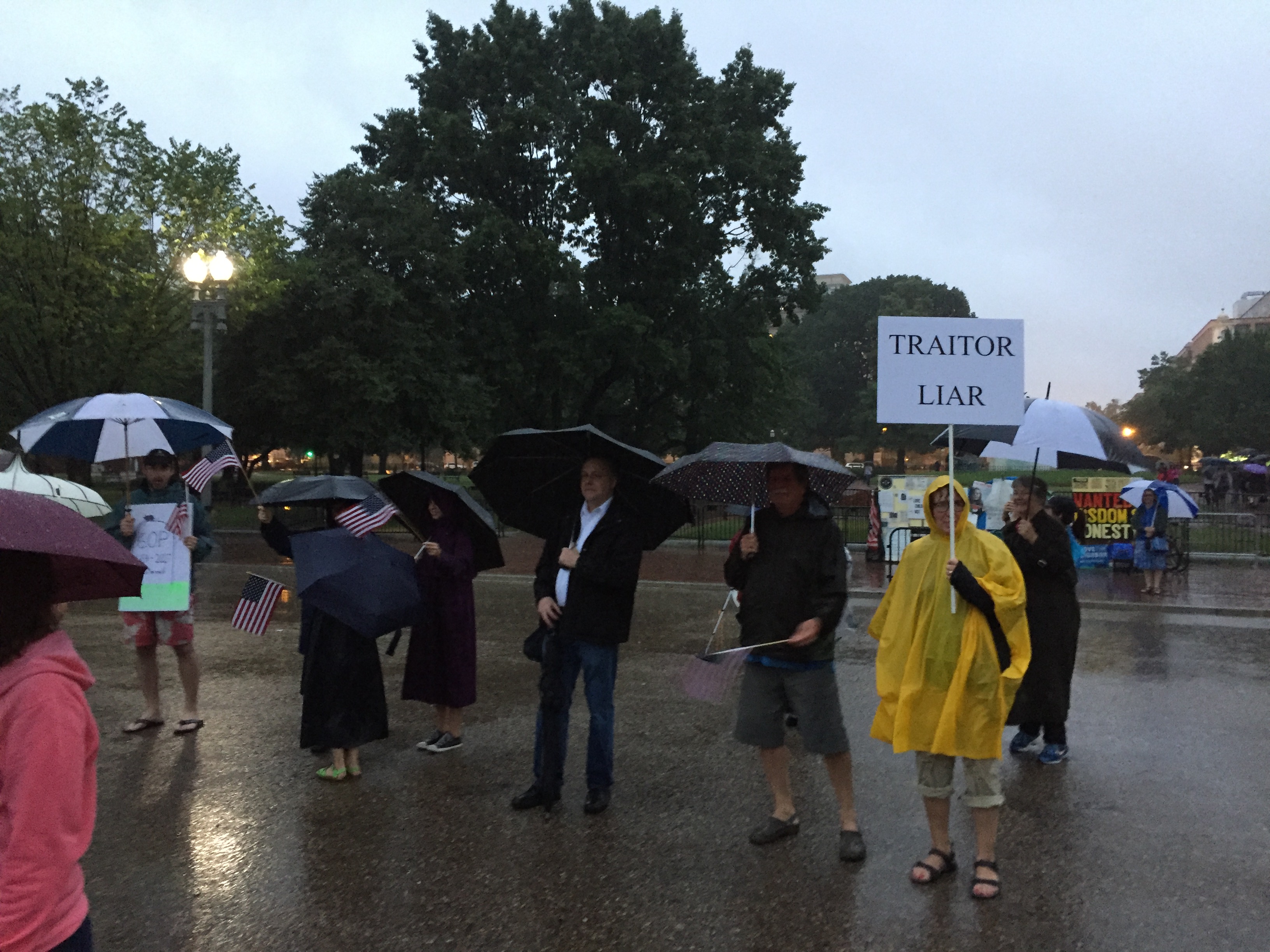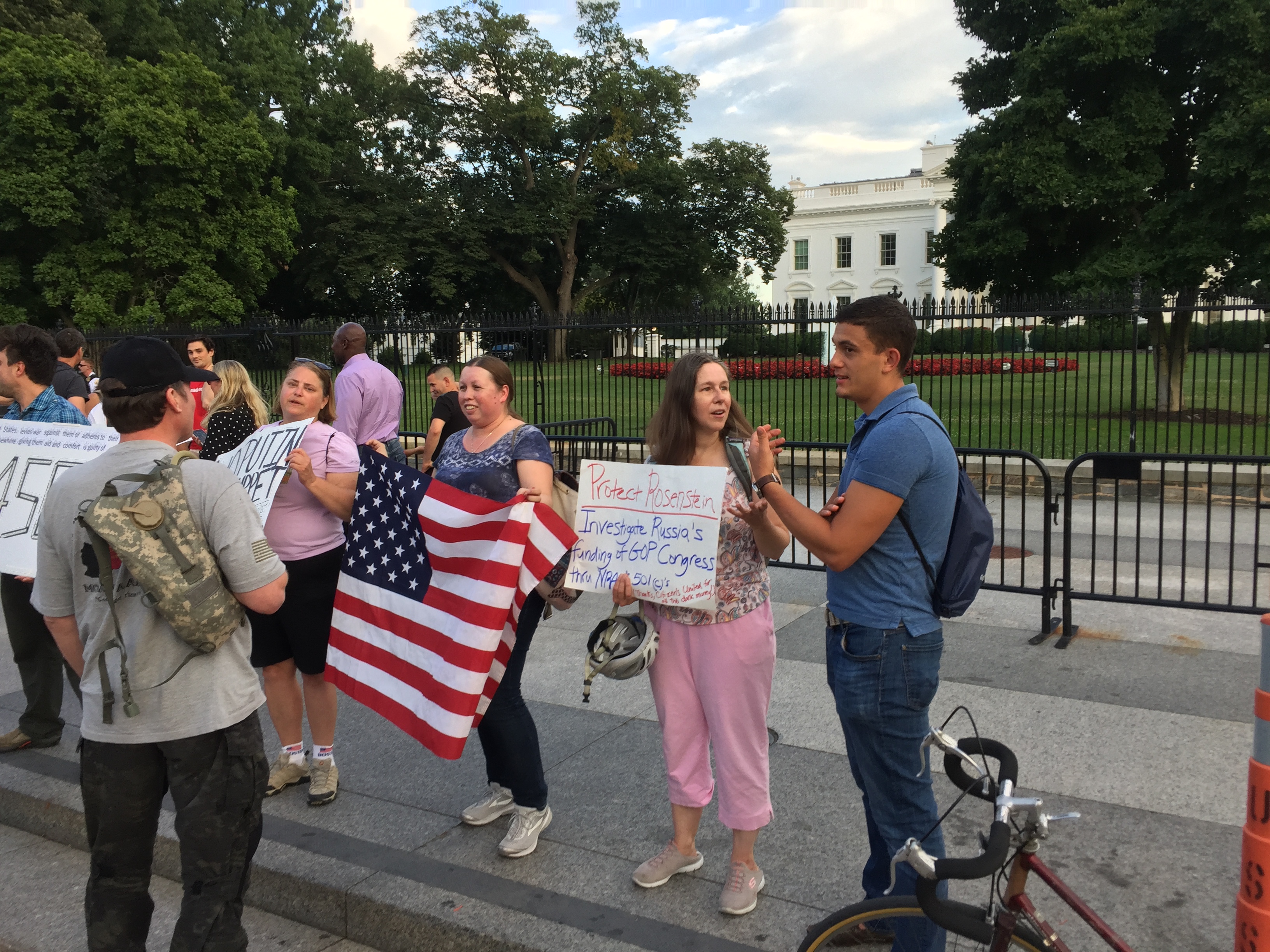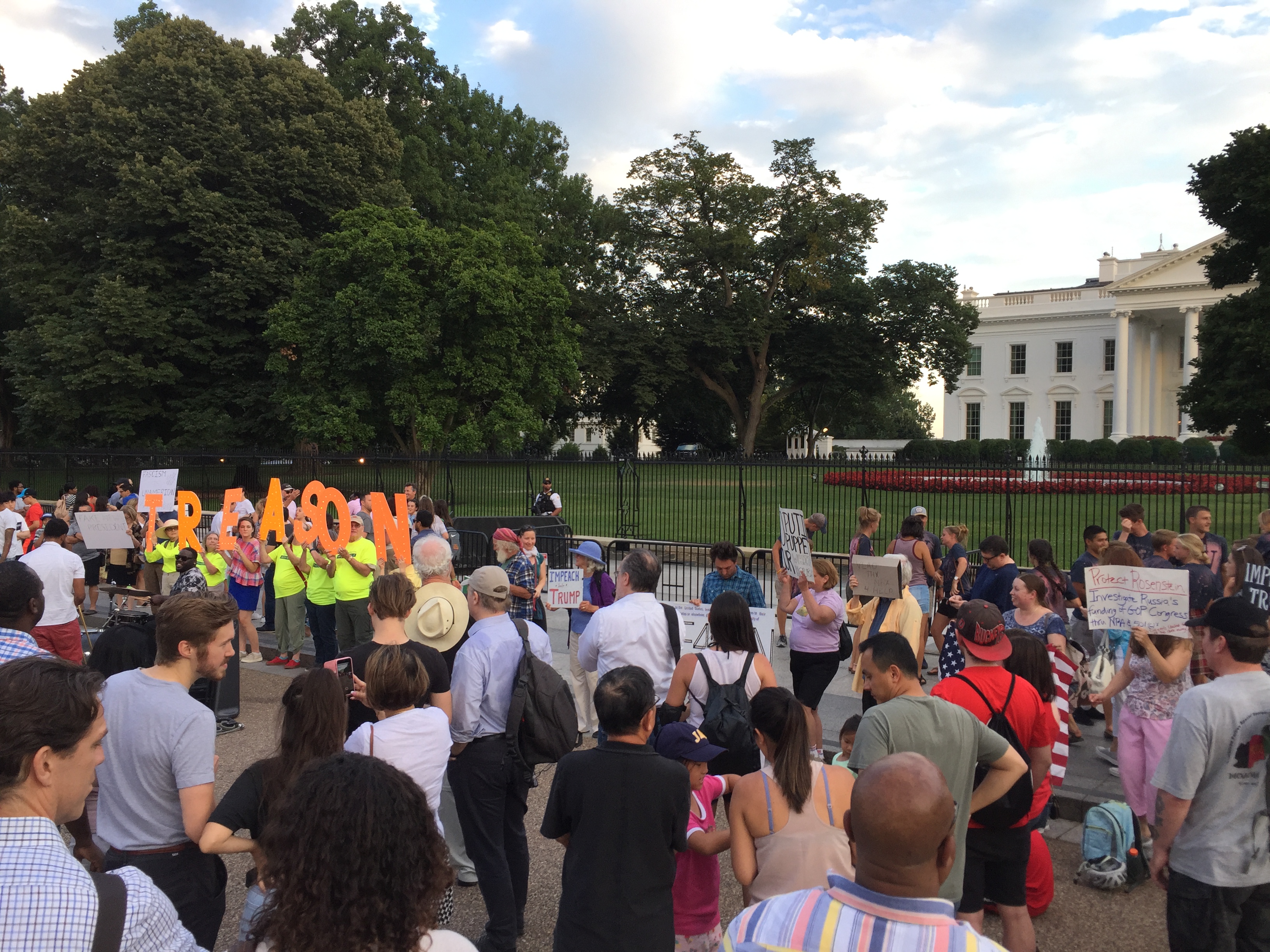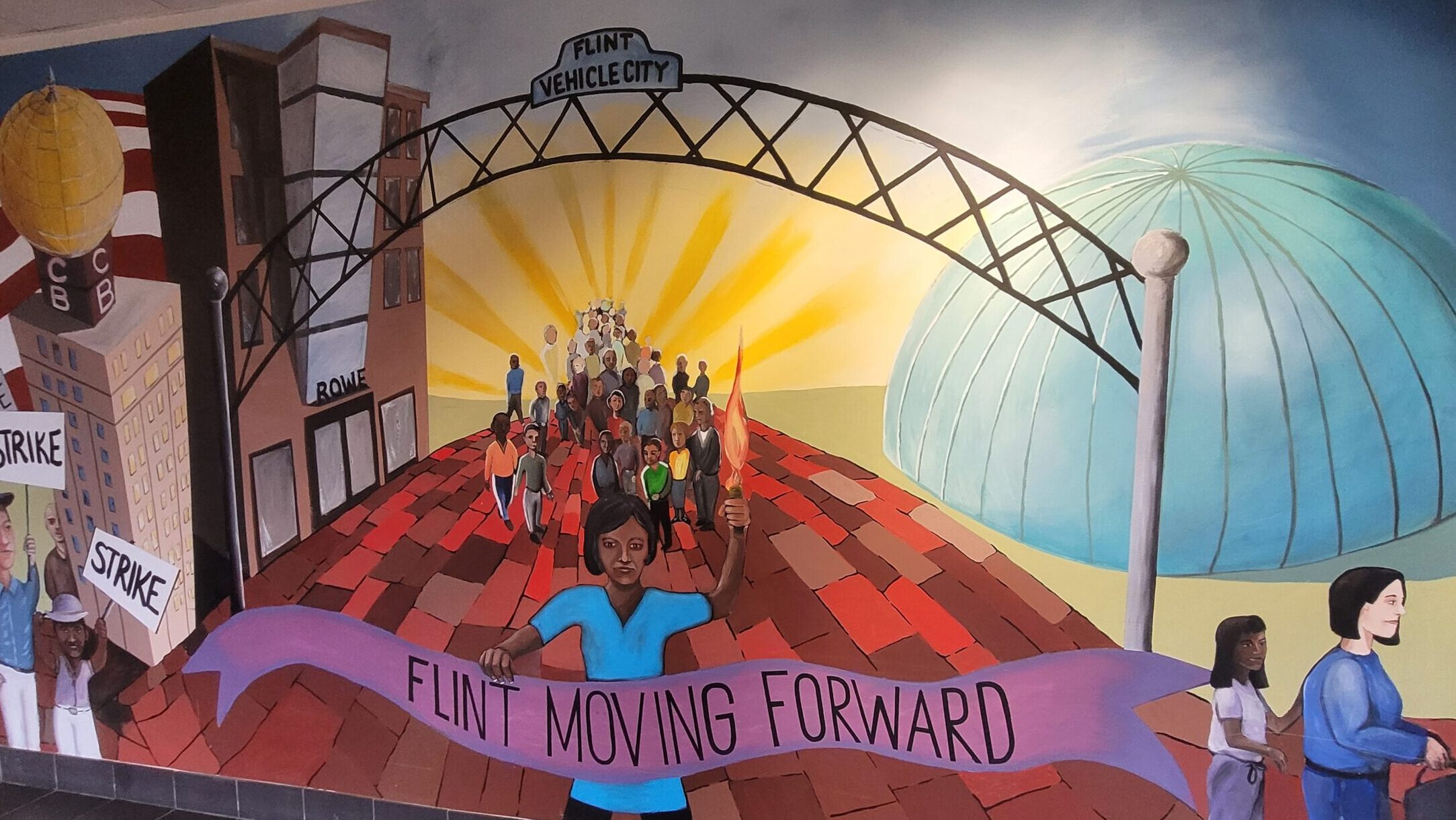The seventh night of the Lafayette Square protests against Donald Trump did not shake the foundations of this lunatic presidency. Trump wasn’t even there, on Sunday evening as lightning flashed and distant thunder rumbled. Neither was the protest. Only on Twitter, after I’d marched back to my hotel in the drizzling rain, did I learn the official part of the event had moved to H Street, on the opposite side of Lafayette Park. Meanwhile, maybe a hundred protesters had shown up where the usual protests had taken place, along with the usual pedestrian tour groups. A few drenched patriots chanted slogans and held up signs. Everybody kept looking around for the events that had been promised for the night: a conga line, apparently, and some noise.
It marked the third consecutive night that I sought out but could not locate the organizer of Occupy Lafayette Square: former Hillary Clinton digital director Adam Parkhomenko, the 32-year-old former field director for Hillary Clinton’s 2016 campaign and a loyalist to Hillary’s presidential aspirations since he was a 17-year-old college student and George W. Bush was only two years into his first term. Parkhomenko is a well-known presence on Democratic Party Twitter and I am becoming resigned to the idea that we may only ever communicate via Twitter, despite my long journey to summertime D.C. Such are things, in these weird days.
Parkhomenko, a Ukrainian-American who was educated here in Washington, is aligned with a number of Trump Resistance figures including Michael Avenatti—who spoke at the protest’s second night, on July 17. It is my luck and perhaps the country’s fate that the star power has since steadily diminished. Alyssa Milano, a popular actress I know solely from her liberal activism on Twitter, also appeared that evening and earned one of the protest’s first mainstream-media acknowledgements, on Page 3 of the Politico newspaper that’s freely available at hotel bars and expense-account restaurants frequented by lobbyists and journalists.

By Thursday night, my first at the protests, the entertainment consisted of a battery-powered speaker in a backpack. People danced. It was a beautiful night and it had a certain mood. On Friday, a group of retirees from the Indivisible group in Herndon made an effective entrance by carrying orange cardboard letters that spelled out TREASON, illuminated by Christmas lights. And then a local trombonist and drummer played with enthusiasm, the rest of the arrangement coming from the trombonist’s cell phone output.
Saturday was the deluge. It poured all day, great sheets of steady rain falling upon a city of yellowing lawns and thirsty trees after many hot, dry weeks. I expected little but still made the four-block walk from my hotel to the north side of the White House, meeting up with a very small and brave collection of humans far outnumbered by passers-by, including a Segway tour group that circled around the few protesters. I made an effort to talk to the Segway riders, and had no luck until a very tall high-schooler in a plastic rain poncho rolled slowly by and allowed that she was “with the protest in spirit.” As she was there in person, I took her meaning to be that she was not there in spirit. And off they went, along with various clusters of visitors who attempted a few phone photos and trudged off through the rising waters. The White House and D.C. police were neither friendly nor aggressive, and they were soaked to the skin like everyone else. There were whispers about a Secret Service man nervously gripping his sidearm during a brief chant against the NRA; this followed a mention of the then-ongoing hostage situation at a Trader Joe’s on the other side of the country.
The Twitter-announced start time of each night’s protest has varied by up to an hour, and on Saturday the promised musicians sheltered by giant umbrellas never made it. As Parkhomenko could not be found amongst the very few attendees, two apparent co-organizers—one who identified herself to me as Maryland Clinton supporter Karen Murphy—took turns repeating a few stock protest phrases through a low-powered bullhorn. The rain pounded umbrellas and soaked through coats and clothes. There was no identifiable program, no speaker to rally the crowd, no sign of the youthful and energetic DSA wing of the opposition party. (Later that night, wondering why the protests felt so unfocused despite such an obvious villain, I invited DC’s Democratic Socialists of America chapter to liven up future proceedings.)

While Trump was nowhere near the White House—he was tweeting and pouting from his golf club in New Jersey—the weekend did see an appreciated victory: Mainstream media was getting aboard with protest coverage. Rachel Maddow reportedly mentioned it on her broadcast, and the websites for Newsweek and The Hill posted fresh items about the ongoing action known online as #OccupyLafayetteSquare.
And, through a ground-floor White House window facing the protest, one or maybe two people kept peering through the curtains. Never has a U.S. president been so despised by his own administrative and domestic staff. Maybe they were with us in spirit.
* * *
Popular protests aspire to be rituals. A fixed protest with a central goal, directed at a target like the pipeline at Standing Rock or a dubious national election as in Ukraine’s Orange Revolution, depends upon a steadily growing number of people and an easy-to-memorize goal or slogan—a meme spread through media and outrage. If the ritual is successful, the movement achieves its goal without violence or bloodshed or waiting for the next dubious election.
The one-day march events long popular in America are meant to make a single-news-cycle statement and serve as a social outing to encourage the believers and make their numbers known to their oppressors. And then the people take their signs and go back home, hoping for the rare kind of action like the Civil Rights Act of 1964, which followed Martin Luther King’s March for Jobs and Freedom by only 11 months.
But each permitted and crowd-controlled million-something march on the National Mall acknowledges the brutal military attack against the Bonus Army occupation of July 1932. More than 40,000 American war veterans and their families set up camp outside the Capitol in demand for payment of their military service bonus. It was the worst year of the Great Depression and many of the soldiers were homeless. Herbert Hoover’s administration launched a savage U.S. Army raid on the family camps, a raid led by Douglas MacArthur. Hanging around after dark is an invitation for your government to attack you, peaceful gathering or not. Even venturing onto the wrong side streets is enough for the government to arrest and prosecute, a lesson learned by the handful of angry demonstrators at Donald Trump’s embarrassing inauguration. If they can set the calvary loose on hungry World War I veterans, they can come after you.





